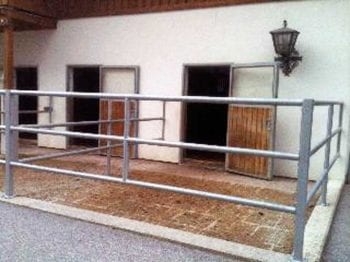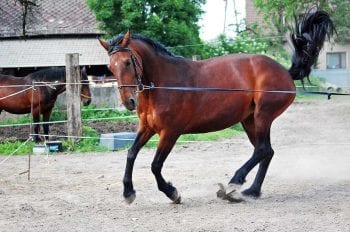16 Sept 2019
Catherine Bell discusses how increased collaboration between vets and paraprofessionals can lower stress in equine patients.

Equine vets and behaviourists are in the business of helping horses from their respective positions of expertise. But what happens when those remits overlap?
Most accredited/reputable equine behaviourists will work under veterinary referral and prioritise the resolution of veterinary issues before initiating behavioural rehabilitation.
However, occasionally, the best course of veterinary treatment can have behavioural downsides – causing the horse increased stress in the short term and possibly worsening the veterinary issue.
How can we resolve these issues together, to offer enhanced benefits to patients?
Stressful situations trigger a response in the amygdala, causing a release of corticotropin-releasing factor (CRF). This triggers the sympathetic nervous system into “standby mode”, preparing the horse for flight – in a process much more rapid than the cortical evaluation that may later recognise the stressor was a false alarm.
The CRF also triggers the hypothalamus, which, in turn, releases more CRF – triggering the pituitary gland to release adrenocorticotropic hormone (ACTH). Finally, ACTH triggers the adrenal glands into releasing cortisol into the bloodstream.
This activation of hypothalamus, pituitary and adrenal glands is known as the HPA axis, providing a feedback loop whereby the cortisol reaches the prefrontal cortex, hippocampus, hypothalamus and pituitary gland, and shuts down the process – providing the stressful situation has ended.
However, in cases of prolonged stress, the long-term presence of cortisol can be associated with depression, anxiety, poor appetite, reduced interest in sex, insomnia, weakening of immune system, and impairments in learning and memory (Sapolsky, 1994).
While most research is undertaken in humans and rats, given the similarities of mammalian limbic systems, no reason exists to assume things may be different for horses.

A common problem with which horse owners will ask for behaviourist help is box rest.
Some horses are well acclimatised to spending time in a stable, but many are not, or may have a tolerance for a short period in a stable before needing increased movement.
This is not unreasonable, given the horse’s evolutionary need to walk and graze for approximately 16 hours a day (McGreevy, 2004).
They also struggle with the social isolation during this time; again, they have an evolutionary need to gain security from herd members.
Enforced stabling commonly leads to box-walking and stress-induced behaviours, such as calling for companions. Additionally, the likelihood of “rebound behaviour” is high once the horse has been permitted limited time out (Chaya et al, 2006).
Owners can face dangerous situations that present significant risks to their safety – for example, attempting to comply with the commonly recommended “controlled in-hand walking”, possibly with a road being the only possible location. Meanwhile, the horse rears and jogs alongside, often risking worsening of the original condition or further injury.
So, what can be done to improve this for both horse and owner? Some horses will cope better if their box rest is, instead, a small corner of the field, remaining close to the familiar turnout group. The permitted area can be enlarged gradually, to reduce the likelihood and severity of frustration-induced movement.
Sometimes, a small yard area or pen can be created outside the stable, offering the horse choice to be inside or outside with improved view of – or contact with – companions. Enrichment options can be provided – the Equine Behaviour and Training Association (EBTA) has produced a free downloadable leaflet (bit.ly/2kiuuSf) for enriching the lives of horses on box rest, providing lots of ideas for vets to pass on to horse owners.
Where possible, however, could box rest be avoided altogether more often for horses that really won’t cope well with it? Many horses that live in consistent herds tend to spend their time calmly walking and grazing, not performing the sort of high-energy movements that would exacerbate injuries.
Pain relief of some form is commonly paired with box rest – and this is another area where behaviourists may sometimes query its use.
Some owners are keen to use pain relief not only for the sake of the horse’s welfare, but for their own desire to return to ridden work as quickly as possible.
No evidence exists to suggest even horses bred or used for regular competition experience boredom or other adverse effects during a more extended rest period – provided they receive adequate socialisation, turnout and enrichment. Therefore, using pain relief would be advised against in cases where the owner’s motivation is more about the riding than the horse’s comfort.
Instead, a culture of longer rehabilitation would be encouraged and, where appropriate, treatment – such as physiotherapy – to allow the horse to recover both physically and emotionally from the pain before the ridden work recommences.
Similarly, the use of hormonal treatments may be questioned for mares that appear “moody” or “stroppy” during their seasons. If the owner’s motivation is more about the desire to “use” the horse than the horse’s welfare, a break from intensive work may be preferable to medication in some cases.
A slightly different and more recent area of concern is the improvements in diagnosis of pituitary pars intermedia dysfunction (PPID). Over the past few years, the number of horses diagnosed and treated for the condition has risen considerably, and many horses have been saved the pain of severe laminitis.
A horse with PPID releases insufficient dopamine to the intermediate lobe of the pituitary gland, consequently losing the inhibitory effect of the dopamine and producing excessive amounts of ACTH (McFarlane, 2011).
A horse suspected of having PPID will, therefore, have its ACTH levels measured via blood test. If the ACTH level is high, the horse will be medicated with pergolide, a dopamine agonist that mimics the action of natural dopamine by inhibiting the amount of ACTH produced (Gehring et al, 2010; Spelta, 2015).
But what about horses that have no clinical signs of PPID other than a high level of ACTH – for example, those tested “just in case” and/or because they are a certain age?

ACTH also rises via HPA axis arousal as a result of stress, not only PPID. Routine management and training of domestic horses provide many possible sources of such stress. Examples include long hours of stabling, inappropriate grain-based feeding schedules instead of ad-lib forage, lack of choice of companions, insufficient socialisation and prolonged training rooted in what are now considered to be aversive techniques – and this is before considering horses that are more actively abused or neglected.
It should also be noted chronically stressed horses tend to become “shut down” – a state that can appear relaxed and compliant, but is actually more passive and analogous to “depression” (Hall et al, 2018).
In humans, depression is linked to activation of the HPA axis, and depression is commonly associated with raised cortisol and ACTH (Inder et al, 2001); again, no reason exists to assume things may be different in horses.
The measured relationship between cortisol in horses and their degree of stress is inconclusive, with studies looking typically at short-term effects of stressors and associated increases in physiological measures (Young et al, 2012).
It has been suggested long-term stress may depress the HPA axis, and result in lower levels of cortisol and ACTH (Visser et al, 2008); however, a thorough understanding of the long-term effects of typical domestic settings – compared with more ethologically minded settings – is still needed. Until then, the possibility high ACTH measurements relate more to the stress inherent in a domestic lifestyle should be considered in cases where no other clinical signs of PPID exist.
Further complicating the picture, a common side effect of pergolide is reduced appetite and an apparent depression, known colloquially as “the veil” (Kellon, 2019), making disentanglement of PPID symptoms and pergolide side effects very difficult.
It may be, to reduce the ACTH levels, the horse needs a behaviourist to advise the owner on how to reduce the environmental stressors – rather than a lifetime on pergolide. At the very least, some evidence exists that a much more gradual introduction of pergolide can mitigate the negative impact of the dopamine agonist, reducing the incidence of depression and food refusal (Perkins et al, 2002; Kellon, 2019).
A final example considers the rates of euthanasia due to behavioural problems. Again, this is an area where enhanced communication between vets and behaviourists could save the lives of horses.
A recent conversation by the author with an owner revealed her vet had diagnosed a “likely brain tumour” and recommended euthanasia on the basis of the horse’s apparently erratic behavioural problems. Further investigation revealed sources of pain and the owner’s description of the behavioural problems were consistent with what a behaviourist would expect for a rescued horse, given too much training too soon while in pain.
Behavioural problems often appear inconsistent and “coming out of nowhere”. Managing human behaviour is a key foundation of a behaviourist’s work – horses respond to how they are treated, trained and managed, and horse owners can be inconsistent and unaware of their own behaviour.
It is, therefore, unsurprising owners do not recognise the horse’s problem behaviours are often more rational and predictable than they may initially appear.
In an attempt to help owners recognise the early signs of fear and distress, the EBTA has also produced a series of videos (bit.ly/21CLwy1) documenting these behavioural indications that all is not well for the horse. By encouraging owners to respond to these precursors, more dangerous behaviours can be avoided.
The author would recommend owners of horses who have fears about procedures, such as injections or hoof handling, are given behavioural modification plans so they can gradually learn to cope with the procedure and reduce their fear responses.
These plans can take a few weeks to months to work through, depending on the diligence of the owner, but their completion can considerably improve the safety of vets who are placed in these situations.
These examples demonstrate how some well-intentioned veterinary care can lead to inadvertent problems for the horse. Very few vets work regularly with equine behaviourists, and increased collaboration would lead to improved outcomes for horses and their owners.
While, traditionally, anyone could call himself or herself an “equine behaviourist”, an increasing number of reputable organisations can provide details of behaviourists who are suitably qualified and registered.
The author would recommend the Animal Behaviour and Training Council, the International Association of Animal Behavior Consultants and the Association of Pet Behaviour Counsellors – as well as the EBTA – for further information.